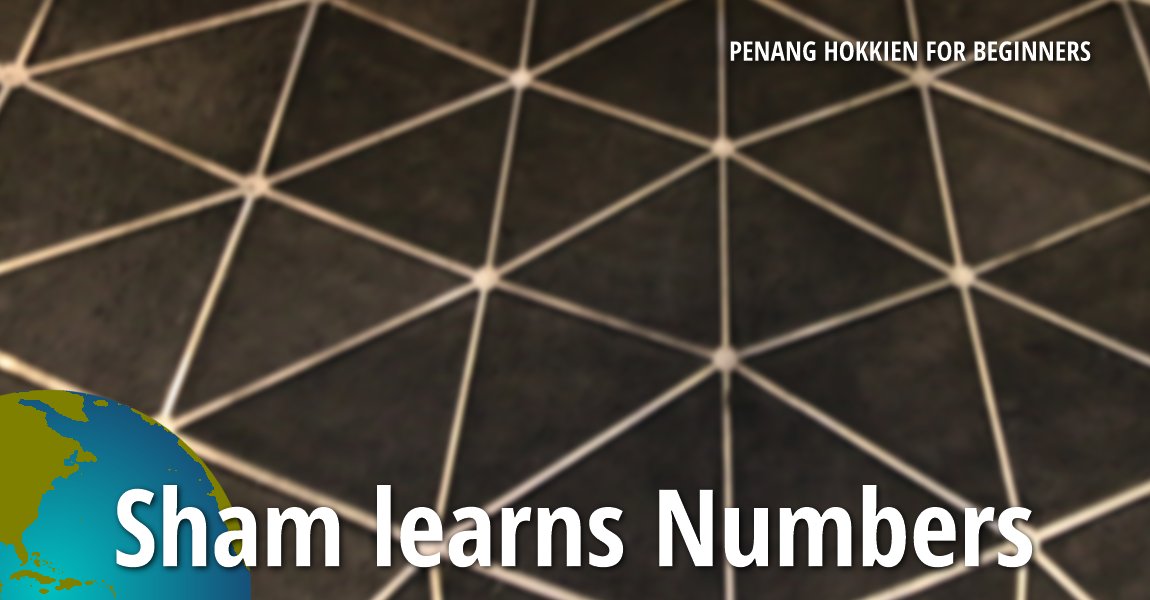 Numbers in Penang Hokkien (7 August, 2016)
Numbers in Penang Hokkien (7 August, 2016)
Reading 1
It's after school. Sham and Jimmy are at Jimmy's home. They are in his room.Sham kah1 Jimmy ti1 Jimmy-eh3 chu3.
 Sham ka33 Jimmy kong4, "Kin3jit1 lu1 ai1 ka3 wah4 ha1mik1?"
Sham ka33 Jimmy kong4, "Kin3jit1 lu1 ai1 ka3 wah4 ha1mik1?" 
Jimmy mui3 Sham, "Kin3jit1 lu1 ai1 ok3 ha1mik1?"

Sham kong4, "Ka3 wah4 ho33bae4."

"E33sai4," Jimmy kong4.
 "Toay3 wah1 kong4: cit1, nor33, snar1, see3, gor33, lark1, chit3, pek3, kau4, cap1."
"Toay3 wah1 kong4: cit1, nor33, snar1, see3, gor33, lark1, chit3, pek3, kau4, cap1." 
"Cit1 pun1 e33 kio3 it3, nor33 pun1 e33 kio3 jee33."

"Ti33si2 kio1 cit1, ti33si2 kio1 it3?"

"Wah4 khah1 ka33 lu1 kong4."
 "Cit3 por3 cit3 por3 lai2."
"Cit3 por3 cit3 por3 lai2." 
"Tan4 cit3 ae33," Sham kong4.
 "Zero Hok1kien1 wa33 kio3 ha1mik1?"
"Zero Hok1kien1 wa33 kio3 ha1mik1?" 
"Zero kio1 khong3."

Reading 1 Vocabulary
Now let's look at the words used in the above conversation.- kah1
 and
and - ti1
 at
at - eh2
 's (to show possession)
's (to show possession)
Example:
Jimmy's house (Jimmy-eh3 chu3).
Eh2 is always hyphenated to the possessor and sandhied to -eh3 if it is followed by the object. If no object is present, then it is not hyphenated, and remains as eh2.
Example:
Whose house? Jimmy's. (Cui33-cui33-eh3 chu3? Jimmy eh2.) - chu3
 house
house - ka33
 with, to
with, to
Depending on context, ka33 can be translated as "with", and sometimes "to". - kong4
 say
say
On its own, "kong4" means "to say", but in constructions such as "ka33 (someone) kong4", it means "to tell (someone)". - kin3jit1
 today
today - ai3
 want, desire
want, desire
The Penang Hokkien word ai3 shares the same Chinese character, 愛, as the Mandarin word "to love". However, its degree of desire is less than that of to love, and so it is translated as "to want". - ka3
 teach
teach
Note that ka3 (to teach) and ka33 (with, to) sound the same but carry different meanings. - ha1mik1
 what
what - mui
 ask
ask - ok1
 learn
learn
We learned this word in the previous lesson. In regular sentences, it sandhies to ok3 if followed by an object or ha1mik1.
Examples:
What do you want to learn? (Lu1 ai1 ok3 ha1mik1?)
I want to learn Hokkien. (Wah1 ai1 ok3 Hok1kien1 wa33.) - ho33bae4
 numbers
numbers
There is no singular or plural in Penang Hokkien, so ho33bae4 can be translated as "number" or "numbers" depending on context. - e33sai4
 can, okay
can, okay - toay3
 follow
follow
Examples:
Say with me. (Toay3 wah1 kong4.)
Do as I do. (Toay3 wah1 co3.) - cit1
 one
one - nor33
 two
two - snar1
 three
three - see1
 four
four - gor33
 five
five - lark1
 six
six - chit3
 seven
seven - pek3
 eight
eight - kau4
 nine
nine - cap1
 ten
ten - it3
 one
one
It3 is actually the "literary reading" of cit1, but to keep things simple, let's just say that "one" can be expressed as "cit1" and "it3"; we will learn when to use which. If you are interested to know more about numbers, go to the chapter on Numbers in Penang Hokkien to take a look. - jee33
 two
two
Jee33 is also the alternative word for "nor33"; we will learn when to use which. - khong3
 zero
zero - pun4
 also
also
The word pun4 usually sandhies to pun1 unless it is the last word of a sentence.
unless it is the last word of a sentence. - e33
 can, possible
can, possible
You can use e33 and e33sai4 almost interchangeably. However, their meanings are not exactly the same. Although both can be translated as "can", e33 edges towards "having the ability to do something" while e33sai4 is "having permission to do something."
Examples:
He can eat five eggs.(Ie1 e33 ciak1 gor33-liap3 nui33.)
He can come in now. (Ie1 e33sai1 jip1 lai2 liau4.) - kio3
 call
call - ti33si2
 when
when - khah1
 will
will
The word "khah" presents a future action, similar to future tense. - por3
 step
step - lai2
 come
come
Although literally translated as "to come", lai2 often appears at the end of sentences to mean "does it". So, "cit3 por3 cit3 por3 lai2" can be translated loosely as "step by step does it". - tan4
 wait
wait - ae33
 moment
moment
You can use the phrase "tan4 cit3 ae33" to say "hold on", "hang on", "wait a moment", etc.
Reading 2
So far, we have learned numbers 0 to 10. Now let's learn 11 to 19.11
 cap3-it3
cap3-it3Note: it's cap3-it3, not cap3-cit1. All numbers are hyphened together.
12
 cap3-jee33
cap3-jee33Note: it's cap3-jee33, not cap3-nor33.
13
 cap3-snar1
cap3-snar114
 cap3-see3
cap3-see315
 cap3-gor33
cap3-gor3316
 cap3-lark1
cap3-lark117
 cap3-chit3
cap3-chit318
 cap3-pek3
cap3-pek319
 cap3-kau4
cap3-kau4Numbers from 20 to 29.
20
 jee33-cap1
jee33-cap1Note: it's jee33-cap1, not nor33-cap1.
21
 jee33-cap3-it3
jee33-cap3-it3Note: cap1 sandhies to cap3 to take a numeral behind it.
22
 jee33-cap3-jee33
jee33-cap3-jee3323
 jee33-cap3-snar1
jee33-cap3-snar124
 jee33-cap3-see3
jee33-cap3-see325
 jee33-cap3-gor33
jee33-cap3-gor3326
 jee33-cap3-lark1
jee33-cap3-lark127
 cap3-lark1
cap3-lark128
 jee33-cap3-pek3
jee33-cap3-pek329
 jee33-cap3-kau4
jee33-cap3-kau4Numbers in the tens are regular, in that you just need to end them with -cap1.
30
 snar3-cap1
snar3-cap140
 see1-cap1
see1-cap160
 lark3-cap1
lark3-cap190
 kau1-cap1
kau1-cap1Numbers 31 to 99 are built the same way as 20 to 29. For example:
31
 snar3-cap3-it3
snar3-cap3-it342
 see1-cap3-jee33
see1-cap3-jee3359
 gor33-cap3-kau4
gor33-cap3-kau4Numbers in the hundreds are also regular. Simply end each with -pak3.
100
 cit3-pak3
cit3-pak3200
 nor33-pak3
nor33-pak3300
 snar3-pak3
snar3-pak3400
 see1-pak3
see1-pak3700
 chit3-pak3
chit3-pak3900
 kau1-pak3
kau1-pak3Numbers from 101 to 999. Note that if the number ends in tens, it can be shortened in informal speech.
101
 cit3-pak1-khong1-it3
cit3-pak1-khong1-it3102
 cit3-pak1-khong1-jee33
cit3-pak1-khong1-jee33105
 cit3-pak1-khong1-gor33
cit3-pak1-khong1-gor33110
 cit3-pak3-cap3, informally as
cit3-pak3-cap3, informally as  pak3-cap3
pak3-cap3113
 cit3-pak1-cap3-snar1
cit3-pak1-cap3-snar1120
 cit3-pak3-jee33-cap3, informally as
cit3-pak3-jee33-cap3, informally as  pak3-jee33
pak3-jee33124
 cit3-pak1-jee33-cap3-see3
cit3-pak1-jee33-cap3-see3208
 nor33-pak1-khong1-pek3
nor33-pak1-khong1-pek3270
 nor33-pak1-chit1-cap1, informally as
nor33-pak1-chit1-cap1, informally as  nor33-pak1-chit3
nor33-pak1-chit3550
 gor33-pak1-gor33-cap1, informally as
gor33-pak1-gor33-cap1, informally as  gor33-pak1-gor33
gor33-pak1-gor33Numbers in the thousands end with cheng1.
1000
 cit3-cheng1
cit3-cheng12000
 nor33-cheng1
nor33-cheng18000
 pek1-cheng1
pek1-cheng1Numbers 1001 to 9999. Note that if the number ends in the hundreds, it can be shortened in informal speech.
1001
 cit3-cheng1-khong1-khong1-it3, can also say
cit3-cheng1-khong1-khong1-it3, can also say  cit3-cheng1-khong1-it3
cit3-cheng1-khong1-it31010
 cit3-cheng1-cap1
cit3-cheng1-cap11025
 cit3-cheng1-jee33-cap3-gor33
cit3-cheng1-jee33-cap3-gor331100
 cit3-cheng1-cit3-pak3, informally as
cit3-cheng1-cit3-pak3, informally as  cheng3-it3
cheng3-it31101
 cit3-cheng1-cit3-pak1-khong1-it3
cit3-cheng1-cit3-pak1-khong1-it31102
 cit3-cheng1-cit3-pak1-khong1-jee33
cit3-cheng1-cit3-pak1-khong1-jee331200
 cit3-cheng1 nor33-pak3*, informally as
cit3-cheng1 nor33-pak3*, informally as  cheng3-jee33
cheng3-jee331300
 cit3-cheng1 snar3-pak3*, informally as
cit3-cheng1 snar3-pak3*, informally as  cheng3-snar1
cheng3-snar1* Note that where there is a pause, the word in front of the pause is in the citation tone. So, 1200 is "cit3-cheng1 nor33-pak3", not "cit3-cheng3-nor33-pak3."
1301
 cit3-cheng1-snar3-pak1-it3
cit3-cheng1-snar3-pak1-it31421
 cit3-cheng1-see1-pak1-jee33-cap3-it3
cit3-cheng1-see1-pak1-jee33-cap3-it33600
 snar3-cheng1 lark3-pak3, informally as
snar3-cheng1 lark3-pak3, informally as  snar3-cheng3-lark1
snar3-cheng3-lark13607
 snar3-cheng1 lark3-pak1-khong1-chit3
snar3-cheng1 lark3-pak1-khong1-chit33670
 snar3-cheng1 lark3-pak1-chit1-cap1, informally as
snar3-cheng1 lark3-pak1-chit1-cap1, informally as  snar3-cheng3-lark3-pak1-chit3
snar3-cheng3-lark3-pak1-chit3Numbers in the ten thousands.
10,000 can be expressed as
 cit3-ban33 as well as
cit3-ban33 as well as  cap3-cheng1
cap3-cheng130,000 can be expressed as
 snar3-ban33 as well as
snar3-ban33 as well as  snar3-cap3-cheng1
snar3-cap3-cheng190,000 can be expressed as
 kau1-ban33 as well as
kau1-ban33 as well as  kau1-cap3-cheng1
kau1-cap3-cheng1Large numbers are often expressed as multiples of ten thousands, rather than multiples of thousands, although both are acceptable.
100,000 can be expressed as
 cap3-ban33 as well as
cap3-ban33 as well as  cit3-pak1-cheng1
cit3-pak1-cheng1210,000 can be expressed as
 jee33-cap3-it1-ban33 as well as
jee33-cap3-it1-ban33 as well as  nor33-pak1-cap3-cheng1
nor33-pak1-cap3-cheng1If every digit has a value, it is more common to use cheng1. Take a pause at the comma.
467,931 can be expressed as
 see1-pak1-lark3-cap3-chit1-cheng1 kau1-park1-snar3-cap3-it3
see1-pak1-lark3-cap3-chit1-cheng1 kau1-park1-snar3-cap3-it3502,000 can be expressed as
 gor33-pak1-khong1-jee33-cheng1
gor33-pak1-khong1-jee33-cheng1The millions are often the highest numbers in common use.
1,000,000 can be expressed as
 cit3-pak1-ban33
cit3-pak1-ban337,000,000 can be expressed as
 chit3-pak1-ban33
chit3-pak1-ban33
Uttering digits
When uttering digits, for example year or telephone numbers, use the digits khong3, it3, jee33, snar1, see3, gor33, lark1, chit3, pek3 and kau4. Note that if there is mention of a word such as ni2 (year), the final digit sandhis.Year 2018
 jee33-khong3-it1-pek1-ni2
jee33-khong3-it1-pek1-ni2Year 1983
 it1-kau4-pek1-snar3-ni2
it1-kau4-pek1-snar3-ni2226 1417
 jee33-jee33-lark1 it1-see3-it1-chit3
jee33-jee33-lark1 it1-see3-it1-chit3012 456 8891
 khong1-it1-jee33 see1-gor33-lark1 pek1-pek1-kau1-it3
khong1-it1-jee33 see1-gor33-lark1 pek1-pek1-kau1-it3Learn Penang Hokkien with Memrise
Now you can use the most user-friendly tool on the web to learn Penang Hokkien. It helps you to listen, understand and memorise. Go to Memrise, and learn Penang Hokkien at your own pace.
Return to Penang Hokkien Resources
Songs about Penang
About this website

Hello and thanks for reading this page. My name is Timothy and my hobby is in describing places so that I can share the information with the general public. My website has become the go to site for a lot of people including students, teachers, journalists, etc. whenever they seek information on places, particularly those in Malaysia and Singapore. I have been doing this since 5 January 2003, for over twenty years already. You can read about me at Discover Timothy. By now I have compiled information on thousands of places, mostly in Peninsular Malaysia and Singapore, and I continue to add more almost every day. My goal is to describe every street in every town in Malaysia and Singapore.
Copyright © 2003-2024 Timothy Tye. All Rights Reserved.


 Go Back
Go Back